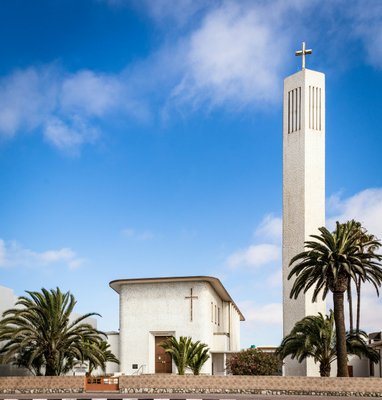This small town in southern Namibia has a German colonial past and sits near the Quiver Tree Forest, where ancient aloe trees grow among unusual dolerite rock formations.
Keetmanshoop lies in southern Namibia’s dry plains, established as a missionary station in 1866. The town connects travelers to unusual sights like the Quiver Tree Forest with its upward-reaching aloe trees, the Giant’s Playground’s stacked volcanic rocks, and buildings from the early 1900s that mix European and local designs. Sunlight bathes the area for most of the year, with daytime temperatures frequently rising above 40°C in summer. You’ll see how the San people adapted plants for survival and how German settlers left their mark on streets and structures. This part of Namibia draws those curious about geology, colonial history, and open spaces where the horizon stretches uninterrupted.
Quiver Tree Forest and Giant’s Playground
Drive 14 kilometers northeast from Keetmanshoop to Gariganus Farm, where hundreds of Aloe dichotoma trees grow in rocky soil. These trees, some three centuries old, were once used by the San people to make arrow holders by hollowing out their branches. Morning and late afternoon light turns the forest into a popular spot for photos and short walks. Nearby, the Giant’s Playground covers an area larger than 10 soccer fields with dolerite rocks piled into towers and arches. Geologists say these formations resulted from volcanic activity and erosion over millions of years, creating paths you can walk through for an hour or two.
Buildings from the German Colonial Era
The Rhenish Mission Church, completed in 1895, uses sandstone blocks and has pointed windows typical of European religious buildings. Inside, wooden beams show carvings by local artisans. A small museum next door holds tools, clothing, and written records from early Nama and missionary residents. The town’s former post office, now a tourist center, still has its early 1900s interior with dark wood furniture and vintage wall maps. Another landmark, the Schützenhaus, was a social club for rifle enthusiasts; its outdoor seating area and historic photos give insight into colonial-era leisure.
Weather Patterns and Travel Timing
Summer months bring extreme heat, with December to February temperatures regularly hitting 45°C in the shade. June through August offers cooler days around 22°C, though nights can drop below 5°C. Rain occurs sporadically, usually in brief thunderstorms between January and March. Visit between April and mid-October to explore comfortably on foot. Pack a refillable water bottle, UV-protective clothing, and closed-toe shoes for rocky terrain.
Naute Dam and Nearby Points of Interest
Naute Dam, a reservoir 45 kilometers southwest, supplies water to the town and attracts birds like pink flamingos and white pelicans. You can fish here with a permit or use the shaded tables for lunch. The Mesosaurus Fossil Site, 35 kilometers west, displays ancient reptile skeletons embedded in stone slabs. For a half-day trip, consider hiking Brukkaros Mountain’s slopes to reach its flat-topped crater. Fish River Canyon, a two-hour drive southeast, has viewpoints overlooking a 160-kilometer-long ravine carved by river water.
Getting Around and Essential Services
Keetmanshoop connects to Windhoek by daily trains and buses, with some routes continuing to South Africa. Shared minivans depart from the bus stop on Kaiser Street for nearby towns. Local taxis operate on fixed routes; agree on fares before getting in. Stock up on supplies at supermarkets along 5th Avenue, where you’ll also find fuel stations and tire repair shops. The tourist office in the old post office building provides free brochures and arranges guided visits to farms with quiver trees. Overnight options include camping sites near the forest and mid-range hotels with air-conditioned rooms.
Local Communities and Economy
Nama families sell handmade jewelry and woven baskets at stands along the B1 highway. Many residents work on farms raising Karakul sheep, known for their curly fleece used in rugs and coats. In September, the town hosts a festival with traditional dances, grilled meat stalls, and live music performances. For meals, try grilled game meat or fresh salads at family-run eateries near the central market. Most key attractions sit within a 30-kilometer radius, letting you return to town before sunset after a day of exploring.










